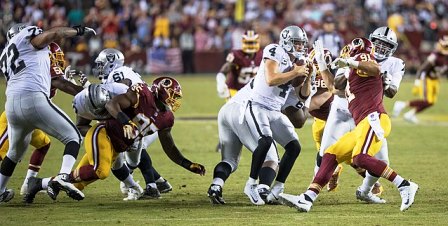Derek Carr played nine seasons with the Oakland/Las Vegas Raiders, guiding the team to the playoffs twice. What caused the Raiders to release Carr before the 2023 NFL season, and why did the New Orleans Saints prioritise him during free agency?
Derek Carr’s Release by the Raiders
Carr has started more Raiders games (142) than any other quarterback in team history, roughly 50 more than second-place Ken Stabler.
Carr was able to reach the top of the team’s leaderboards in most statistical categories because to his volume and the current NFL passing era. Carr has attempted more passes, passed for more yards, and scored more touchdowns than any other Raiders quarterback.
Although wins aren’t always indicative of a quarterback’s performance, Las Vegas fared 63-79 in Carr’s starts.
That poor team performance, along with head coach Josh McDaniels and general manager Dave Ziegler taking over the Raiders in 2022, contributed to Carr’s departure from Las Vegas.
The Contract Extension That Didn’t Happen
Carr signed a three-year, $121.5 million contract agreement with McDaniels and Ziegler in April 2022, potentially tying him to the team for the foreseeable future. Carr said that the new contract provided the Raiders with “continuity” on offence after the Raiders paid first and second-round selections to acquire Davante Adams from the Green Bay Packers that summer.
However, although the agreement provided Carr with a modest rise for the 2022 season, it also provided the Raiders with additional freedom and enabled them to dismiss Carr after the season.
Carr’s $33 million base salary in 2023 and $7.5 million of his 2024 contract would have been fully guaranteed three deals after the Super Bowl.
Instead, Las Vegas decided on Carr before the regular season ended. Carr was benched before Week 17, and the Raiders turned to backup Jarrett Stidham to ensure Carr didn’t lock in any injury guarantees.
While Vegas sought to sell Carr before the guarantees kicked in, the no-trade provision he earned as part of his agreement provided the now-32-year-old with enormous power. Carr refused to waive his no-trade clause knowing he could choose his own club if released, forcing the Raiders to remove him, freeing up roughly $30 million in salary space for Las Vegas.
What made the Saints sign Carr as a free agent?
Before the Raiders released Carr, the Saints were interested in acquiring him. New Orleans’ executives spoke with Carr while he was still under contract with the Raiders, and the Saints and Raiders agreed on trade compensation if Carr agreed to give up his no-trade power.
Carr, on the other hand, understood he could likely receive a better free agent deal than his previous contract with the Raiders, which would have carried over to the Saints in the case of a trade. Carr also had no motive to compel his new team to give up a first selection to Las Vegas in order to sign him since he could just join with New Orleans once freed.
While the New York Jets and Carolina Panthers both indicated interest in Carr after he was released, the Saints always seemed to be the leader.
Carr formally signed to a four-year, $150 million deal with the Saints on March 6, approximately three weeks after being released by the Raiders. The pact includes $60 million in completely guaranteed money. Carr is the NFL’s 14th highest-paid quarterback, earning $37.5 million per year on average.
Since Drew Brees retired at the end of the 2020 season, the Saints have been looking for a long-term replacement as quarterback. Before tearing his ACL, Jameis Winston flourished in 2021, while Andy Dalton outperformed expectations in 2022. However, neither was the franchise quarterback the Saints desired.
While it remains to be seen if Carr can produce the outcomes that New Orleans is looking for, the Saints have committed to him for at least the next two years.
More in Sports: https://buzzing.today/sports/
Photo Credits: https://commons.wikimedia.org/
